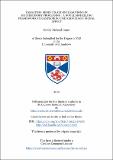Targeting benefits and interactions in multisensory processing : a novel modelling framework for exploring the redundant signal effect
Abstract
An overarching goal of multisensory research is to understand the rules by which multiple sensory signals are combined to produce behavioural benefits. One example of a multisensory benefit is that response times (RTs) to multisensory signals are faster than RTs to either component unisensory signal (the redundant signal effect). In contrast to other areas of multisensory research, a common explanatory model framework (and thus the basic combination rule) has yet to emerge for multisensory RT benefits. One key reason for this lack of progress would seem to be that additional processing interactions are infrequently quantified, and are rarely incorporated into a formal model of RTs. In this thesis, I assess the ability of a previously-neglected model class – so called race models – to account for both benefits and interactions. To do so, I develop and apply a comparative approach to RT analysis. This approach tests different experimental factors which attempt target sources of benefits and interactions. The effect of these manipulations is compared across 3 key analytical steps. First, the size of the multisensory benefit (i.e. the redundant signal effect) is computed, and compared to the basic prediction of the race model combination rule. Second, indicators of processing
interactions beyond the basic combination rule are quantified. Third, a formal race model is applied to explain benefits and processing interactions. By consistently applying this comparative approach, I demonstrate that the race model framework offers a simple yet powerful account of multisensory benefits across participants. This suggests a basic combination rule for multisensory RT benefits. In addition, a new interpretation of interactions emerges by applying a race model framework, which highlights an important role of context. This approach suggests a common foundation for future studies of multisensory RTs, which can implement the same analytical steps within a wide range of experimental contexts.
Type
Thesis, PhD Doctor of Philosophy
Rights
Attribution-NonCommercial-NoDerivatives 4.0 International
http://creativecommons.org/licenses/by-nc-nd/4.0/
Collections
Except where otherwise noted within the work, this item's licence for re-use is described as Attribution-NonCommercial-NoDerivatives 4.0 International
Items in the St Andrews Research Repository are protected by copyright, with all rights reserved, unless otherwise indicated.


